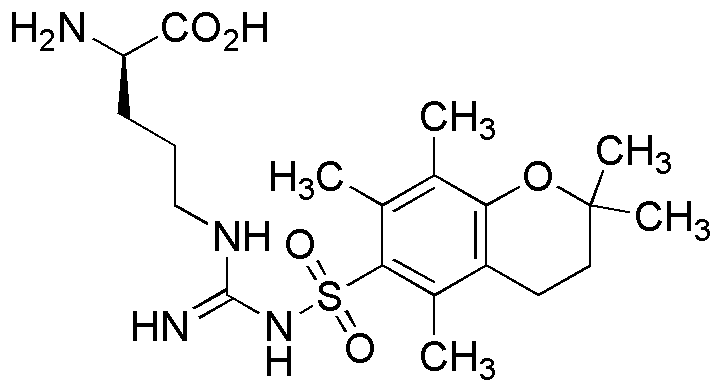Nw-(2,2,5,7,8-Pentamethylchroman-6-sulfonyl)-D-arginine is widely utilized in research focused on:
- Pharmaceutical Development: This compound is instrumental in designing new drugs, particularly in targeting specific receptors in the body, which can lead to more effective treatments with fewer side effects.
- Biochemical Research: It serves as a valuable tool for studying protein interactions and enzyme activities, helping researchers understand complex biological processes.
- Neuroscience: The compound is used in studies related to neuroprotection and neurodegenerative diseases, providing insights into potential therapeutic strategies.
- Diagnostic Applications: Its unique properties allow for the development of advanced diagnostic tools, enhancing the accuracy of disease detection.
- Material Science: The compound can be incorporated into materials for improved performance in various applications, such as drug delivery systems and biocompatible coatings.
Informations générales
Propriétés
Sécurité et réglementation
Applications
Nw-(2,2,5,7,8-Pentamethylchroman-6-sulfonyl)-D-arginine is widely utilized in research focused on:
- Pharmaceutical Development: This compound is instrumental in designing new drugs, particularly in targeting specific receptors in the body, which can lead to more effective treatments with fewer side effects.
- Biochemical Research: It serves as a valuable tool for studying protein interactions and enzyme activities, helping researchers understand complex biological processes.
- Neuroscience: The compound is used in studies related to neuroprotection and neurodegenerative diseases, providing insights into potential therapeutic strategies.
- Diagnostic Applications: Its unique properties allow for the development of advanced diagnostic tools, enhancing the accuracy of disease detection.
- Material Science: The compound can be incorporated into materials for improved performance in various applications, such as drug delivery systems and biocompatible coatings.
Documents
Fiches de données de sécurité (FDS)
La FDS fournit des informations de sécurité complètes sur la manipulation, le stockage et l’élimination du produit.
Spécifications du produit (PS)
Le PS fournit une description complète des propriétés du produit, notamment sa composition chimique, son état physique, sa pureté et les exigences de stockage. Il détaille également les plages de qualité acceptables et les applications prévues du produit.
Certificats d'analyse (COA)
Recherchez des certificats d'analyse (COA) en saisissant le numéro de lot du produit. Les numéros de lot et de lot se trouvent sur l'étiquette d'un produit, après les mots « Lot » ou « Lot de fabrication ».
Numéro de catalogue
Numéro de lot/série
Certificats d'origine (COO)
Ce certificat d'exploitation confirme le pays dans lequel le produit a été fabriqué, et détaille également les matériaux et composants utilisés et s'il est issu de sources naturelles, synthétiques ou autres sources spécifiques. Ce certificat peut être requis pour les douanes, le commerce et la conformité réglementaire.
Numéro de catalogue
Numéro de lot/série
Fiches de données de sécurité (FDS)
La FDS fournit des informations de sécurité complètes sur la manipulation, le stockage et l’élimination du produit.
DownloadSpécifications du produit (PS)
Le PS fournit une description complète des propriétés du produit, notamment sa composition chimique, son état physique, sa pureté et les exigences de stockage. Il détaille également les plages de qualité acceptables et les applications prévues du produit.
DownloadCertificats d'analyse (COA)
Recherchez des certificats d'analyse (COA) en saisissant le numéro de lot du produit. Les numéros de lot et de lot se trouvent sur l'étiquette d'un produit, après les mots « Lot » ou « Lot de fabrication ».
Numéro de catalogue
Numéro de lot/série
Certificats d'origine (COO)
Ce certificat d'exploitation confirme le pays dans lequel le produit a été fabriqué, et détaille également les matériaux et composants utilisés et s'il est issu de sources naturelles, synthétiques ou autres sources spécifiques. Ce certificat peut être requis pour les douanes, le commerce et la conformité réglementaire.


